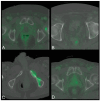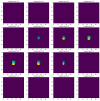Detection of Local Prostate Cancer Recurrence from PET/CT Scans Using Deep Learning
- PMID: 40361501
- PMCID: PMC12071661
- DOI: 10.3390/cancers17091575
Detection of Local Prostate Cancer Recurrence from PET/CT Scans Using Deep Learning
Abstract
Background: Prostate cancer (PC) is a leading cause of cancer-related deaths in men worldwide. PSMA-directed positron emission tomography (PET) has shown promising results in detecting recurrent PC and metastasis, improving the accuracy of diagnosis and treatment planning. To evaluate an artificial intelligence (AI) model based on [18F]-prostate specific membrane antigen (PSMA)-1007 PET datasets for the detection of local recurrence in patients with prostate cancer. Methods: We retrospectively analyzed 1404 [18F]-PSMA-1007 PET/CTs from patients with histologically confirmed prostate cancer. Artificial neural networks were trained to recognize the presence of local recurrence based on the PET data. First, the hyperparameters were optimized for an initial model (model A). Subsequently, the bladder was localized using an already published model and a model (model B) was trained only on a 20 cm cube around the bladder. Finally, two separate models were trained on the same section depending on the prostatectomy status (model C (post-prostatectomy) and model D (non-operated)). Results: Model A achieved an accuracy of 56% on the validation data. By restricting the region to the area around the bladder, Model B achieved a validation accuracy of 71%. When validating the specialized models according to prostatectomy status, model C achieved an accuracy of 77% and model D an accuracy of 77%. All models achieved accuracies of almost 100% on the training data, indicating overfitting. Conclusions: For the presented task, 1404 examinations were insufficient to reach an accuracy of over 90% even when employing data augmentation, including additional metadata and performing automated hyperparameter optimization. The low F1-score and AUC values indicate that none of the presented models produce reliable results. However, we will facilitate future research and the development of better models by openly sharing our source code and all pre-trained models for transfer learning.
Keywords: DenseNet; PC; PET/CT; [18F]-PSMA; artificial learning; deep learning; positron emission tomography; prostate cancer.
Conflict of interest statement
R.A.W. and A.K.B. received speaker honoraria from Novartis/AAA and PentixaPharm. R.A.W. reports advisory board work for Novartis/AAA and Bayer. A.K.B. is a member of the advisory board of PentixaPharm. All other authors declare no conflicts of interest. The funders had no role in the design of the study; in the collection, analyses, or interpretation of data; in the writing of the manuscript; or in the decision to publish the results.
Figures








References
-
- Fendler W.P., Eiber M., Beheshti M., Bomanji J., Calais J., Ceci F., Cho S.Y., Fanti S., Giesel F.L., Goffin K., et al. PSMA PET/CT: Joint EANM Procedure Guideline/SNMMI Procedure Standard for Prostate Cancer Imaging 2.0. Eur. J. Nucl. Med. Mol. Imaging. 2023;50:1466–1486. doi: 10.1007/s00259-022-06089-w. - DOI - PMC - PubMed
-
- Andrearczyk V., Oreiller V., Abobakr M., Akhavanallaf A., Balermpas P., Boughdad S., Capriotti L., Castelli J., Le Rest C.C., Decazes P., et al. Head and Neck Tumor Segmentation and Outcome Prediction. Volume 13626. Springer; Cham, Switzerland: 2023. Overview of the HECKTOR Challenge at MICCAI 2022: Automatic Head and Neck Tumor Segmentation and Outcome Prediction in PET/CT; pp. 1–30. - DOI - PMC - PubMed
Grants and funding
LinkOut - more resources
Full Text Sources
Research Materials
Miscellaneous

